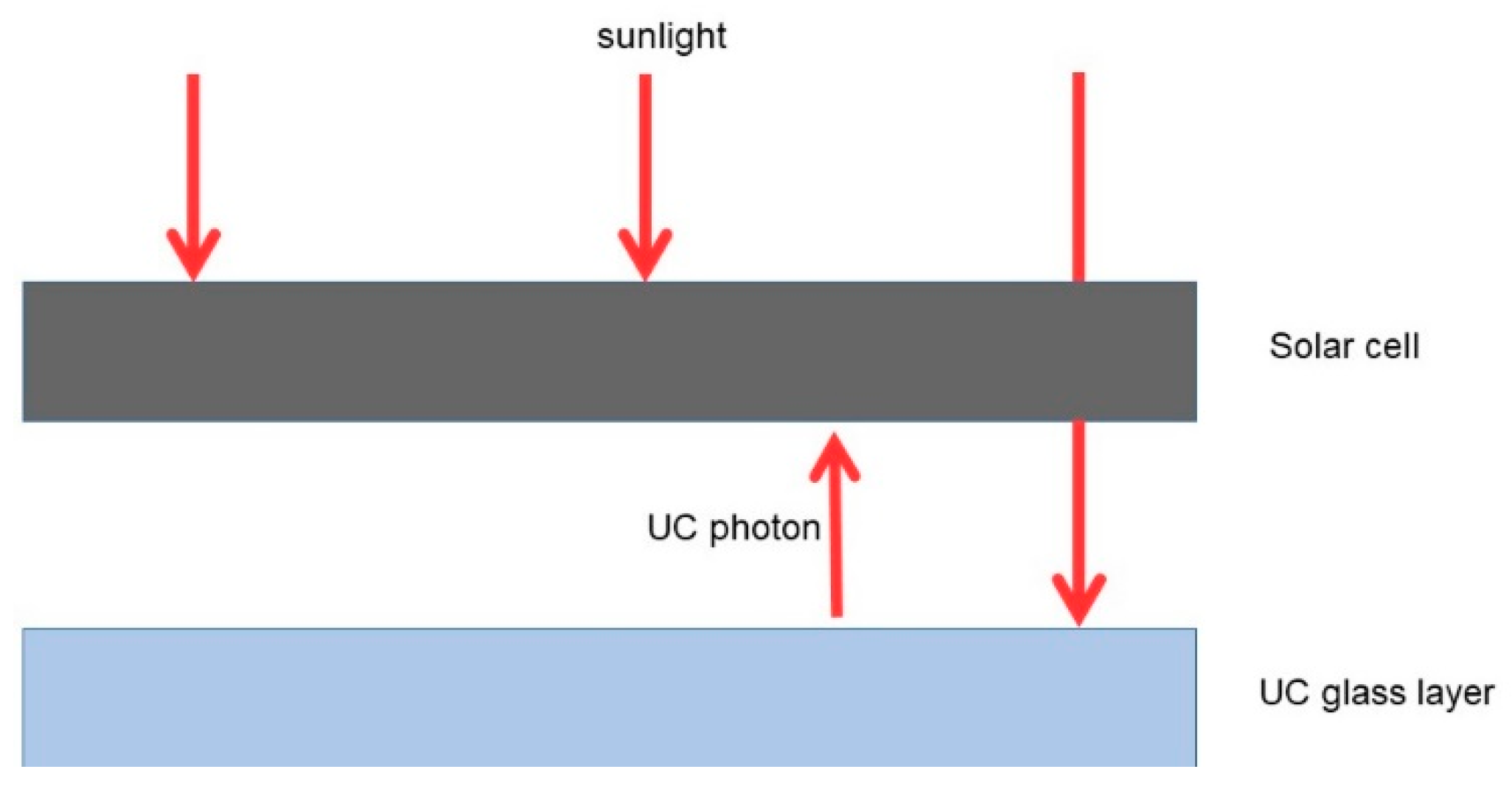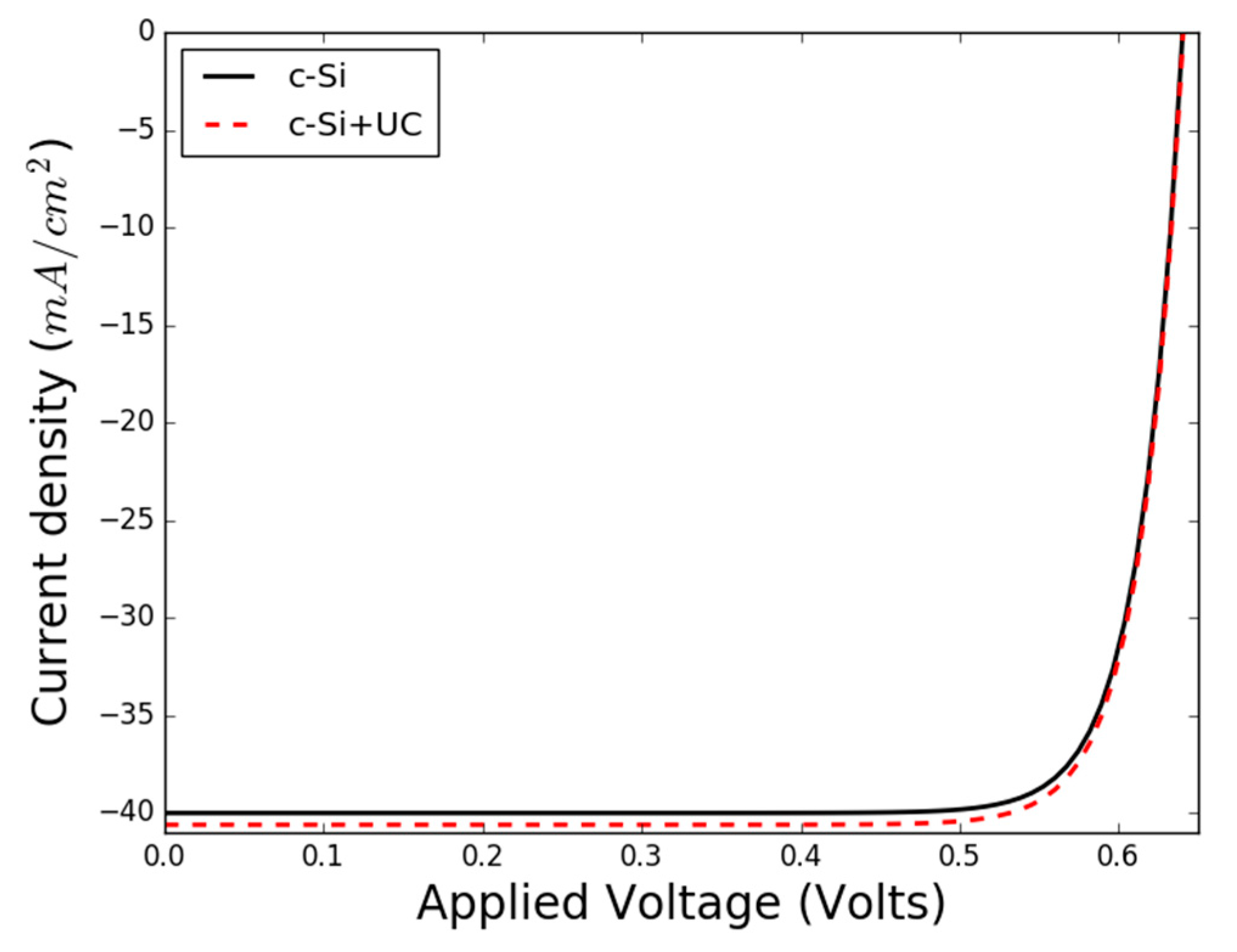1. Introduction
The conversion efficiencies of silicon-based solar cells are getting closer and closer to the theoretical limit of 34% for single-junction silicon-based solar cells, as estimated by Shockley and Queisser in 1961 [
1]. These impressive numbers must, however, be compared to the theoretical efficiency limit of 85% for a generic photovoltaic device [
2], which shows that there is plenty of room for improvements. The main losses in a typical semiconductor solar cell are due to the thermalization of electrons in the UV and visible range of the solar spectrum, the inability of such devices to absorb photons with energies below the electronic band gap, and losses due to the recombination of electrons and holes, which occur particularly at the contacts. A recent survey of novel design strategies to overcome these problems has been given by Polman and Atwater [
3], but their main focus was on multi-junction solar cells. Another promising strategy for single junction solar cells to harness light outside their typical frequency ranges is frequency conversion using rare earth ions, as suggested by Trupke [
4]. From a technical point of view, the most common way to introduce frequency conversion into a standard solar cell is through additional functional glass layers containing rare-earth ions. In device simulations of solar cells, we may cater for the new light management features through calculating the additional photon fluxes that result from the frequency conversion processes in these additional functional layers.
In this work, we want to demonstrate this approach for a model solar cell. In this proof-of-concept approach, a standard solar cell model is augmented by adding the effects of an additional up-conversion (UC) glass layer. After describing some of the technical background related to up-conversion, we also highlight some of the relevant processes involved in typical UC applications for solar cells by using a rate equation model. We also explain in some detail how a typical device simulation is carried out, and we emphasize the crucial role of the size of the model glass layer for the performance of a model c-Si solar cell device.
2. Up-Conversion in Solar Cells
In the context of solar cells, up-conversion is used to absorb sub-band-gap photons from the solar spectrum and convert them into higher-energy photons in the normal absorption range of the solar cell. The up-converted photons can be utilized by the solar cell to produce electron-hole pairs, which drive the corresponding photocurrents [
2]. Note that about 20% of the solar energy reaching the surface of the Earth is not utilized by conventional silicon solar cells, as these photons have energies smaller than the band gap of the semiconductors in the solar cell [
5]. Therefore, UC provides an attractive method to harness these lower-energy photons, reducing spectral losses. This increases the photocurrent and improves the overall efficiency of the solar cell. A simplified diagram illustrating the UC process is given in
Figure 1.
In general, the UC process requires a luminescent material with multiple energy levels that have an appropriate energy spacing. This allows for the emission of photons with frequencies close to the band gap of the solar cell. It is well-known that lanthanide ions, such as Er
3+, have these properties, which can easily be embedded into glass layers for the purpose of UC [
6,
7]. One of the approaches that are currently being studied in Reference [
8] is the systematic doping of optical materials with one or more of these so-called activator ions, with the possible inclusion of sensitizer ions, such as Yb
3+, as co-dopants.
4. Er3+ Up-Conversion Term Scheme
To describe up-conversion properly, four physical processes need to be considered, which are: ground state absorption (GSA), excited state absorption (ESA), spontaneous emission (SPE), stimulated emission (STE), and energy transfer (ET) [
11]. Many lanthanides are suitable for up-conversion applications. Of those, the trivalent Erbium (Er
3+) features a rather simple term scheme, which makes Er
3+ a good study case without adding unnecessary complexity.
A Er
3+ term scheme is shown in
Figure 2, which only considers the processes and states relevant for UC. The processes of GSA and ESA are assumed to be resonant. Three metastable states are shown, from which some further electronic transitions (accompanied by the emission of photons) originate with branching ratios
βij. Here,
i denotes the initial state of such a transition, whereas
j denotes the final state [
12].
The rate equations for this basic system are given by [
12]:
is the pump rate used to populate the excited states. In the case of solar cells,
is given by the incoming photon flux
around the up-conversion wavelength, as well as the absorption cross-section
[
13]. The exact line position and line width depend on the host material of the UC layer, meaning this approximation shall suffice here.
is the total population density of the active erbium ions within the up-conversion glass layer.
and
are the cross sections and lifetimes for state
, respectively.
denotes the branching ratio from state
to state
.
,
,
, and
are the population densities for various states of the Er
3+ ion.
Equations (8)–(10) describe the population changes of the meta-stabile excited states, while Equation (11) guarantees conservation of electrons. An extra equation for the ground state population is not needed, as the system of equations is later solved in the steady-state case, for which the system is already complete. Equation (8) includes the change in through pumping from , as well the emission. The population of is fed by pumping from the ground state and emission from , and loses population through pumping to and emission. is populated through emissions from and , and emits itself back to the ground state.
5. Results and Discussions
A reference 1-D crystalline silicon (c-Si) solar cell is modelled using Equations (1) and (2) [
9,
10]. For the calculation of
in Equation (1), the sum of the different current densities was specified as
. The operating temperature of the device was chosen to be 300 K.
is estimated by computing Equation (2), where the absorber thickness
was chosen to be
. The resulting I–V curve for this model solar cell is given by the solid curve in
Figure 3. Alternatively, a reference solar cell which can be modelled by various device simulation packages such as GPVDM [
12] can be used. In this approach, the resulting photon fluxes from the UC layer are used to augment the photon flux values on the actual spectrum file in the program codes. We stick to using our reference solar cell model for this work.
In the steady state, the population densities
,
,
and
do not change over time, and can be calculated as a function of the pump power
, provided
and all necessary constants in Equations (8)–(11) are known. The important parameters needed to solve for the population densities are given in
Table 1.
In the Er
3+ term scheme,
leads to photoemission with 550 nm wavelength, which is the relevant transition for up-conversion applications. The corresponding lifetime
for
is 0.37 ms [
13]. The values in
Table 1 are used to estimate the additional current density from the UC material layer. All the parameters for crystalline silicon used in the subsequent calculations are taken from [
9].
The generation rate from the up-converted photons is calculated using an absorption coefficient of for c-Si at 550 nm. With this, the photon flux calculated from Equation (3) is . Using Equation (8), the corresponding generation rate is obtained as . This should be compared to the generation rate of a c-Si solar cell without UC.
It is important to note that the estimated photon flux strongly depends on the size of the glass layer. A very thick glass layer, like the present one, may strongly exaggerate the additional photon flux due to UC. Also, for very thick glass layer attenuation (Beer’s law), the additional photon flux needs to be considered. Therefore, our guideline is to use glass layers of a size that leads to measurable increases in overall efficiency (i.e., in the range of %), but with the final aim of identifying optimum UC systems, where these glass layers may be kept very small.
A certain increase in photon flux does not imply a proportional increase in solar cell efficiency, because the solar cell is a nonlinear device. It is necessary to calculate the corresponding current densities. Using Equation (5), we may determine the additional photocurrent density derived from the UC process. The total current density can then be determined by using Equation (6). The resulting J–V curves are shown in
Figure 3, for a c-Si solar cell with (solid black curve) and without (dashed red curve) the UC current density contribution.
Without the frequency conversion layer, the efficiency of the model c-Si solar cell is 21.4%, with a short circuit current of and an open circuit voltage of Using Equation (5), the additional current density that is derived from the UC glass layer is . This results in a total short-circuit current of . The open circuit voltage is not affected.
The efficiency of the model c-Si solar cell, including contributions from UC, is 22.7%. The overall increase in efficiency for the c-Si solar cell by adding our Er3+-based luminescent glass layer model is 1.3%. The increase in efficiency in this proof-of-concept example is, of course, small. It stems from one specific up-conversion channel only, and the example did not include any sensitizer co-dopants. More importantly though, this modelling approach can be applied to more complex and realistic up-conversion set-ups to find good up-conversion configurations.
Some experimental work has been done studying the impact of frequency conversion, such as UC, on solar cell device performance. In their recent publication, Kumar et al. [
14] found a UC improvement of about 0.4% for a dye-sensitized solar cell that uses Er
3+ and Yb
3+ co-doped ZnO up-conversion (UC) nanoparticles-based phosphors. Grigoroscuta et al. [
15] have also studied the effect of a phosphor film of Yb
3+/Er
3+-co-doped CeO
2 on the performance of a silicon-based solar cell and have noticed a significant increase in the cells’ performance because of the thin UC film. A simplified modelling approach such as this can be useful in aiding the development of more advanced solar cells.









